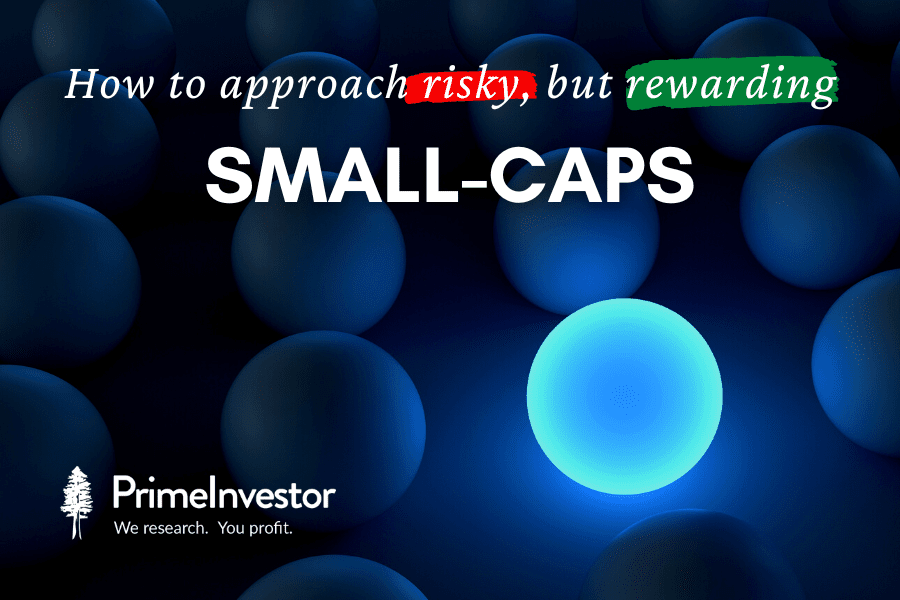In most equity portfolio constructs, the majority of holdings are large, well-known companies. Here, there is no joy of discovery except a steady and modest index-matching return over the years. But as a person’s investible surplus rises, one goes in search of smaller companies. This is a logical progression but not a rule.
Small caps are always alluring to the investor. Everyone knows that it is difficult to make quick money in large well-known and well-researched stocks. We all want to find that small gem which turns a lakh of rupees into crores. The most money is made in such cases when we can spot a company that will turn out to be a market-leading name in five to ten years. Today, the investor population has increased dramatically. Besides, information is available to everyone. This makes small cap investing both interesting and risky.

Slim survival rates
If I go back to the eighties and nineties, of the many small cap companies that were around then, only a handful have gone on to become money multipliers. I can see names like SRF, Eicher, Enfield, Alkyl Amines, Hatsun, Page, TVS Motors that have rewarded investors handsomely. They were small cap companies that have gone on to become mid-caps and sometimes even large caps. But it needs to be recognised that most of the small cap companies of those days continue to remain small or don’t even exist any longer.
Once upon a time, we had companies like Century Textiles, Nirlon, Premier Automobiles, Orkay that were small and promising. So, it was your skill and luck which determined whether you picked the right small caps that could grow your wealth.
Today, information is easily available. Access to top management is a matter of public knowledge. Thus, spotting promising businesses ahead of everyone and getting in early into a sound small cap is not so easy. There are probably more analysts than the number of listed companies to track. Everyone is searching for the hidden gem.
I am, however, a believer in this ‘small company’ philosophy. When in CRISIL, we all got employee stock options – ESOPS – as reward. Post listing, many people sold the stock promptly because it was not well known at the time and the rating business was nascent. But the credit rating boom is just beginning. There were 5000 plus companies in the listed space and many more in the unlisted space that would need ratings.
The business did not need fresh capital to scale up and was knowledge-driven. This was even before S&P took over. If we had put some numbers together as to how CRISIL would look in ten, twenty and thirty years ahead, the story would have been screaming in your face.
But to me, CRISIL is a good illustration of how most of us get anchored to ‘current’ valuations and fail to see the long-term picture. CRISIL did its IPO at Rs.50 per share and never made a call on capital. It got acquired by global rating giant S&P at Rs.750 or so per share. Adjusted for splits, the share is now worth Rs.30,000!! Do the numbers.
However, that is one success. I’ve also had many failures or companies that simply did not grow up. They remained juvenile or just wound up or vanished or got taken over. The fact that we still do not have that many companies with over Rs.5000 crore of market cap in the Indian universe. Take banks. Many private banks started around 1995. Today HDFC Bank and Kotak shares would have multiplied your wealth, whereas a Global Trust Bank would have decimated it.
So how does one approach small cap investing? I have a few pointers, based on what I have seen thus far. I am not very good at the new fad of investing in companies that do not seem to be able to report a bottomline without using brackets. I still believe in looking at PAT, after ensuring that tax is being paid. Not for me the fancy numbers like EBITDA, EBITDA or other nomenclatures which are glamorous-sounding that give one simple message- Boss, we do not know how to make a profit!
An investing approach
Here are my personal learnings on small cap investing.
#1 They shouldn’t be your first investment
Before venturing into this high-risk high-reward zone, it is best to plan one’s core portfolio around more stable investments. This should include fixed income, provident funds and equity mutual funds/ ETFs. Of course, if you are so wealthy that there is money sloshing round, then you can stop reading further and do as you wish.
#2 Commit amounts that are meaningful
To make a meaningful difference to your net worth, you need to commit a reasonable amount to small caps. I would think that a minimum of a couple of lakh per idea would be required. If you want to get invested in ten ideas over a time frame, then you need that much more. I am taking ten as a number out of my hat. The money has to be in more than two or three concentrated bets.
Of course, if your cash flow permits, you are free to place large bets on some ideas. It is based on your comfort zone. The way I look at this is, that in twenty years, some company shares would have gone up 100 to 200 times, some would have just about given you bank returns and maybe one or two would have perished. On the aggregate, this must give better returns than the broad indices. If not, there is no point in pursuing a small cap strategy.
#3 Bet for the long haul
Buy the shares of the company you’ve identified in two or three lots until you get to a sizeable position. You may end up buying on the rise, but that is better than averaging the price on the way down and sitting down for a mediocre return. Unless you think that your basic premise is flawed or there is fraud or a corporate action involving this company, do not sell the stock. I would not monitor daily prices. I would keep track of the annual reports and be alert on the lookout for any news on the company / promoter.
Choosing companies
This is the most difficult part. Today, if I look at the list of companies with market capitalisation below Rs.5000 crores that also have a ROCE of at least ten percent, I get about 700 companies, the smallest having a market cap of around Rs 2 crore! I also see in that group, some names that have been around for four decades and still remain small companies.
I use a screening tool to create an initial shortlist (PrimeInvestor.in has a good one). To screen, work with a checklist. Say – potential to grow faster than GDP, Promoter quality, Accounting quality, Free Cash Flow, Past growth rates, Customer reviews and so on. You should be able to identify the key reason as to why the company makes money. And a conviction that it can make more money going forward because there’s a big market out there for its product or service. I also believe that commodity stocks will not fit the bill here. Commodity stocks are (to me) a value play.
While choosing companies for early stage investing, I tend to look for the following characteristics:
- The business has to be such that it can grow top line rapidly without constraints. When I say constraints, take a dedicated auto ancillary. It is limited by the size of the auto industry and can only scale to be a small part of it. It may remain small for longer than we think. At the same time, a retail business or a Dixon type of business has a huge growth runway ahead. The problem is to find enough such opportunities.
Today, the deadly combination of Private Equity plus free pricing means that when promising small companies enter the public markets for the first time, they are already mid to large in terms of market cap and the valuation has skimmed off much of the return potential. But IPOs can still throw out winners, if reasonably priced. D-Mart was one such. HDFC AMC was not as attractive as Dixon. However, these are businesses which meet the requirements for early investing for big gains.
- Today, there are many small cap companies which have been around for a very long time but could still be good investments. Some auto ancillaries come to mind. Yes, they may not become large, but can give you above-index returns. This is what we have to focus on. These are typically high growth companies. They may have some debt, but enjoy high ROCE to take care of repayments. They have a USP in terms of niche or quality or customer fulfilment or a strategy that gives them the edge. Their execution is typically good.
- These stocks can often be priced more aggressively than the big and boring ‘solid’ names. The speciality chemicals sector threw up many such instances in the past 2-3 years. The Page Industries stock was never cheap but has been a great wealth creator. One example I can cite today is ACRYSIL (confession- I own the stock). They manufacture a product that is always going to be needed and they have the quality. The potential to grow is big. I was lucky to spot this stock a bit early. It has been around for many years, but it is only in the last few years that it has gained traction.
- The wait for a small cap to be recognised by markets can often be painstaking and long. The rise in price happens in sudden bursts. It is never a linear graph. It can be a frustrating wait for a long time and then it suddenly jumps up in a vertical take-off. This is why the crucial quality in small cap investing is resisting the temptation to exit.
- When choosing companies, go for those which have a healthy ROCE (well above the cost of debt), manage their working capital cycle very well and are rarely seen in the corporate arena of M&A. I recall one hot potato stock named ‘Opto Circuits’. However, it had enough warning signals that helped me keep away. Financial inspection is an absolute must. If a business sounds too good and the stock hasn’t been re-rated by markets, think ten times about placing your bet. Most good investments are easy to understand businesses. We must understand how the company can make money.
- Trace the company’s equity history. In the early stages, the promoter holding should be as high as possible. This leaves some room for one or two rounds of dilution in case of need. While this is not a hard and fast rule, I like to see companies where the promoter has a large enough stake. Typically, a good company will not make a follow-on public offer. An IPO followed by one or two rounds of QIP is what the path should be.
- Governance is the biggest risk factor for small caps. Therefore, promoter quality has to be checked. Ask customers/vendors about the promoters. For a small cap company to scale up, good promoters with integrity and passion are a must. I am seeing many old companies that were dull and boring, now get a new lease of life with the next generation, who seem to understand the joys of the capital market, giving them the drive to grow business aggressively.
What to watch for
Small cap companies need more frequent and diligent tracking than established bluechips.
Once you have invested, keep a watch on any corporate action. If the company you own has a penchant for acquisitions, be cautious. If the company is being acquired, it makes sense most of the time to sell and get out. Keep tabs on the headline growth numbers and on cash flow. For how long? Frankly, I do not know. I would think that if I have gone in with a ten year view, I should not change my mind. Once the stock becomes large enough for many institutional investors and promoter stakes to start to come off, I will probably think of exit.
The risks to execution are many. Just look at the retail space. When Future Retail started, we all thought that it was an early mover in a space that is bound to grow by leaps and bounds. Sadly, execution was poor. D-Mart, though a late entrant, did brilliantly in the same space and is still growing. So many others have come and gone or are simply mediocre. The gig economy threw up so many opportunities. However, the absence of a profit makes them poor candidates. The presence of PE and VC Funds also denies most of us the opportunity to get in time to make some money.
It is not easy to discover new picks today. In this age of information overload and high density of equity ‘experts’ virtually every small stock seems like a winner. You will need to take time to pick up a good quality business. Once you find out two or more candidates, buy in gradually. Bad markets are generally the best time to pick up such stocks. A SIP in small stocks is difficult given the high impact costs. Therefore, one has to time the buying price. Small cap stocks are easy to buy and tough to sell. Assume that you will give up five to ten percent of your paper gains when you actually sell.
On the NSE, there are approximately 200 companies with market capitalisation of more than Rs.25,000 crore and probably around 2000 companies that are less than Rs.5000 crore in market capitalisation. This tells us that the odds of scaling up are very low. More often, we will be left to dig for tiny sub-Rs.1000 crore market cap companies that can probably go up five to ten times.
This is a minefield and one has to be prepared to lose money. But this is where many of the investors I know spend their time and money. Some of them get it right. Most of them do not. Choose wisely, depending upon your stomach lining. Remember, as you venture from small to micro caps, there is no information that can be considered authentic. You are on your own.







5 thoughts on “How to approach risky, but rewarding small caps”
No doubt a good article
But..
how about including small cap investing directly in stocks vis-a-vis small cap mutual funds? That would have given a more comprehensive article and addressed more completely the requirements of Investors
Also how about having a premium screener made, saved and directly available in your Premium Screeners section covering all that you have to say and once has to consier?
Thanks
Small caps are a minefield rightly said, and small investors are the last in line to know what is happening on ground.
Held Nirlon Orkay,RIL it’s just odds some survive, it’s lucky if you are still holding it
Informative Article. I am not into direct stocks. Investments in Small caps is through Mutual Funds
Very Nice Article… You told virtually everything without telling specifics… Specifics are indeed to be learnt case to case basis by individual investors… I am still to learn DIY Stock Investment n still to learn reading balance sheets.. Hence stay away fm it.
I think, most of the retail investors can stay away fm Small Caps if they want to save time n money… Proper Asset Allocation, Risk Profiling, Diversification, Goal based Investing, Timely Review n Rebalancing etc. are more than enough for most of us..
If at all needed then one can invest 10% of Equity in 1-2 Small Cap MFs with differentiated strategies and low overlapping portfolio. Tag it to real long term goals which are 15-20 years away.
Ur Article was Bang On Target for those who wants to experience Magic of Small Caps.
Thank you. As usual, excellent article from Bala sir. Please make sure he writes more often for PrimeInvestor.
Comments are closed.